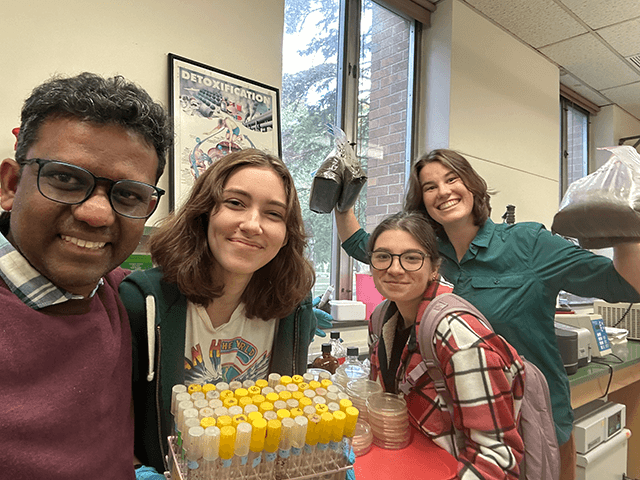
Over the last two weeks of August, there was a visible impact to the Benedictine Sisters’ Glinodo property as the goat herd from Let’s Goat Buffalo cleared out the invasive species along the Creekside trail. (Read more on this years’ long collaboration here). This is the third summer that the goats have visited Glinodo, eating everything green so native plants have equal opportunity to flourish against such species as Japanese knotweed and multi flora rose. Years into this process, the impact of this work is notable, and the influence the goats’ presence has on the land goes far deeper than what meets the eye.
Throughout this past month, the Mercyhurst University Office of Sustainability teamed up with the university’s microbiology department to study the effects of ruminant animals on soil health. Mercyhurst’s Sustainability Coordinator, Molly Tarvin, noted that this study was inspired by last year’s university Earth Day lecturer Rachael Shenyo, who discussed the natural fertilizer and carbon capture benefits of land browsed by goats or sheep. Shenyo’s claim was that the browsing, hooves, and feces of ruminate animals, such as goats, help bolster soil microbiomes, fungi mycelium, carbon content, and nutrition levels.
Earlier in August before the goats arrived, the Mercyhurst researchers collected samples from two different plots: one where the goats have never been, one where the goats have visited at least twice over the last three years. They then cultured the bacteria and sent it for DNA sequencing and nutrient components. These results will show the microbe, fungal, and nutrient presence as it relates to the goat’s presence on those plots of land. Next, the researchers will study the microbe activity in the goat droppings and compare to the control plot after the goats have visited.
“This process has been ongoing, and involves lots of dirt, goat poop, and days in the lab,” says Tarvin. “Our results will help determine whether the presence of goats truly is good for the soil, and if so, drive the argument that they are the best option for landowners looking to clear invasive weeds. Why spray chemicals, when you can feed both goats and your soil?”
Photo: Dr. Raj Mohan, Maggie Pete '26, Emma Stitzenberg '26, and Molly Tarvin in Mercyhurst’s microbiology lab
